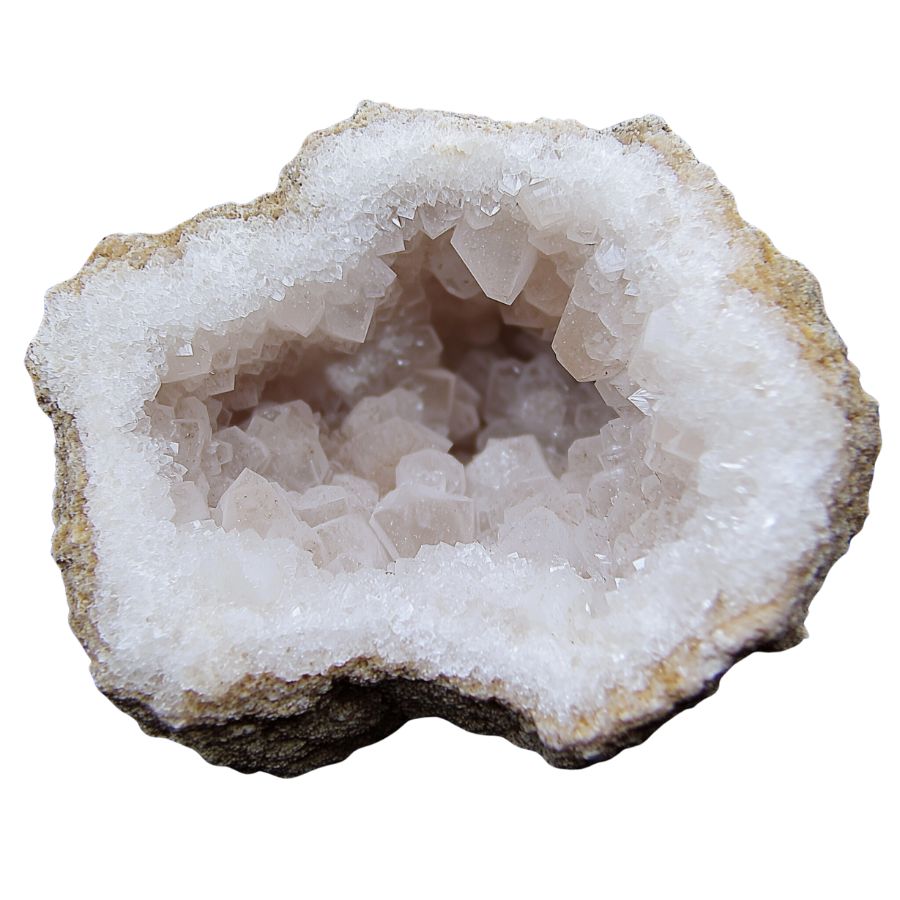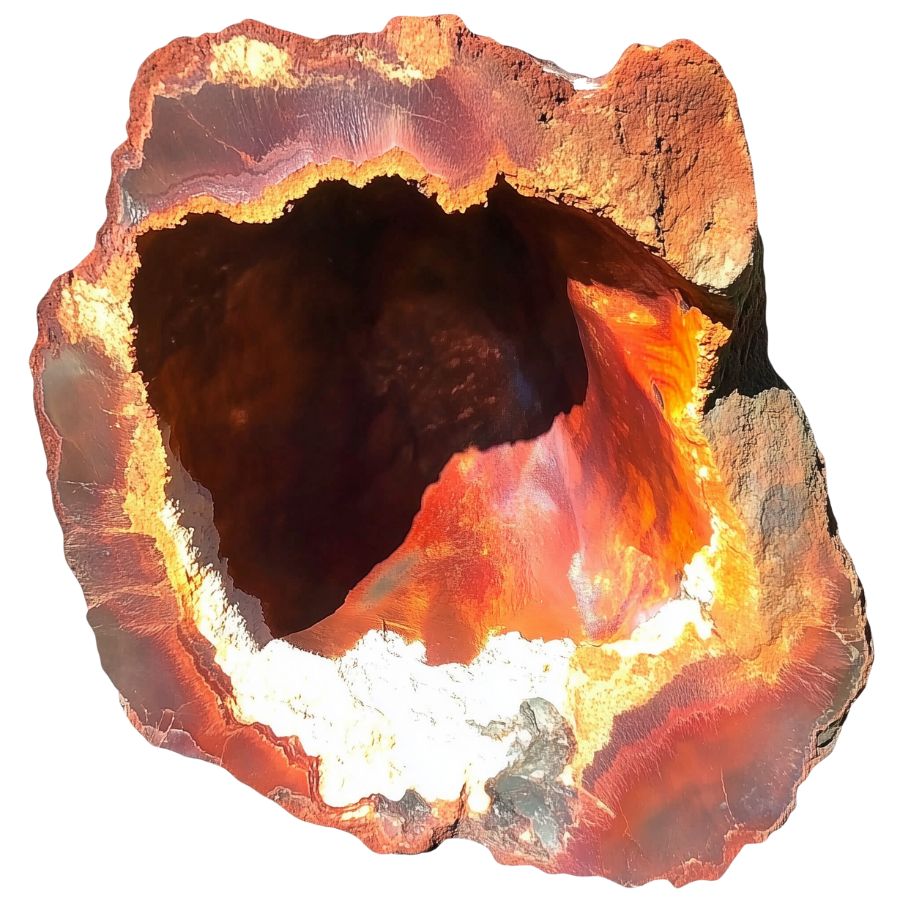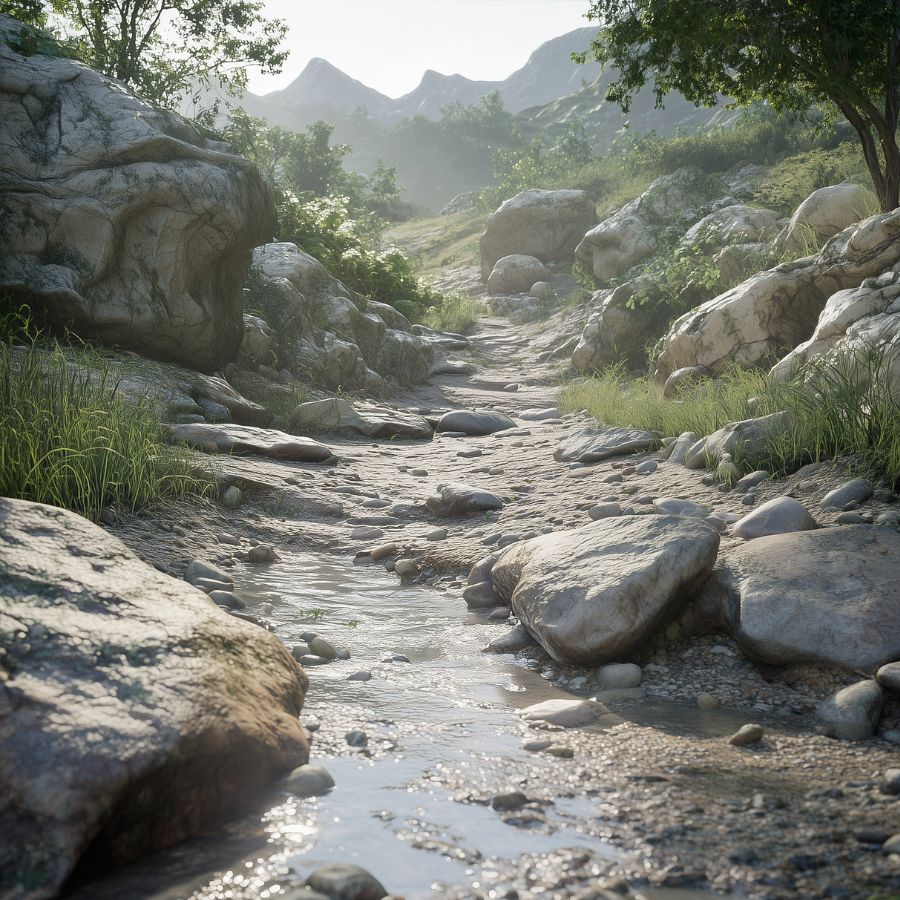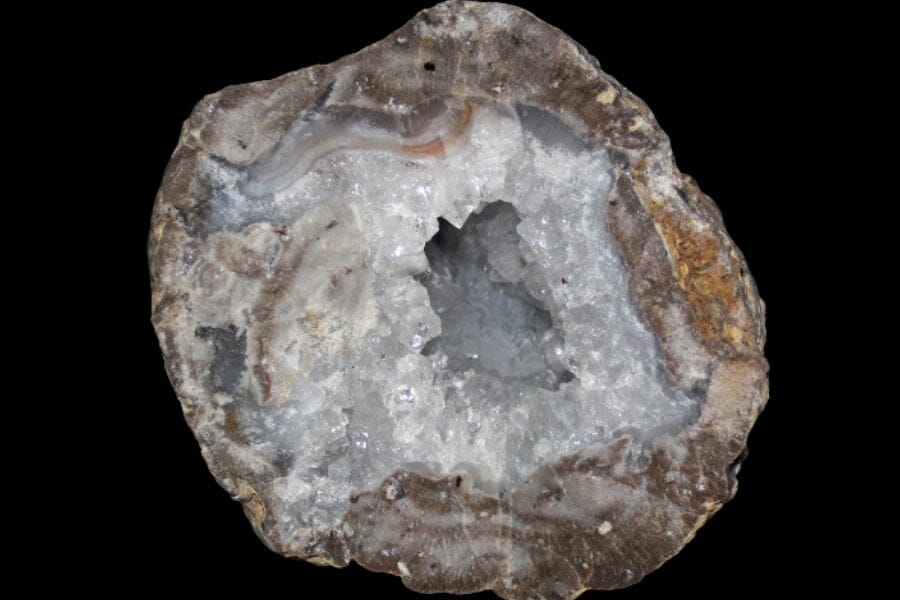Geodes are like nature’s surprise eggs, filled with sparkling crystals inside a plain-looking rock. Our state is a treasure trove for these hidden gems, with its many different landscapes that make it perfect for rock hounds.
If you’re itching to crack open your own crystal-filled wonder, you’re in the right place!
This article will show you the best spots in our state to find geodes. We’ll also share some handy tips to make your geode hunting adventure a success.
So grab your hammer and get ready to discover the beauty hiding in ordinary-looking rocks all around this state!
How Geodes From Here

Geodes form when bubbles in volcanic rocks or spaces in sedimentary rocks get filled with minerals over time.
First, water rich in minerals like quartz or calcite seeps into the hollow space. As the water evaporates, it leaves behind the minerals, which slowly build up layer by layer.
Eventually, these minerals create a crystal lining inside the geode. The outer shell stays rough, while the inside becomes a sparkling treasure.
The process can take thousands, even millions, of years, making each geode a unique and beautiful time capsule of Earth’s natural forces.
The Types Of Geodes Found in the US
There are many fascinating varieties of geodes that can be found across the United States, including in our own state. Each type is distinctly beautiful and intriguing:
Amethyst Geode

Amethyst geodes look plain on the outside, like a potato. But crack them open, and you’ll find stunning purple crystals. These crystals can be light lavender or deep purple.
The structure of crystals inside can vary widely. Some are tiny and densely packed, creating a sparkling surface. Others form large, distinct points that jut inwards.
The color range is impressive too, from pale lilac to deep royal purple. Some amethyst geodes develop unique features. “Stalactites” of amethyst might hang from the top.
In rare cases, you might find a water bubble trapped inside, a remnant from the geode’s formation millions of years ago.
Citrine Geode

Citrine geodes are eye-catching rocks with golden yellow to orange crystals inside. They sparkle when light hits them, looking like sunshine trapped in stone. The colors come from iron mixed in with the quartz.
Unlike many gemstones, citrine’s color is often evenly distributed throughout the crystal.
Most citrine on the market isn’t natural. It’s actually heat-treated amethyst. This process turns the purple amethyst into vibrant citrine. Natural citrine is rarer and often has a more subtle color.
Pyrite Geode

Ever cracked open a rock and found gold inside? Well, not real gold, but something that looks just like it. That’s a pyrite geode. Pyrite is called “fool’s gold” because it’s so shiny and golden.
Inside these geodes, pyrite forms in cool shapes. Sometimes it’s perfect cubes. Other times its clumps or even round balls called “pyrite suns”.
Pyrite has a fun history. People have been mixing it up with real gold for thousands of years. That’s how it got its nickname.
Selenite Geode

Selenite geodes stand out from the crowd. They’re white and see-through, with a glassy look. When you open one up, you’ll see crystals that look like they’re made of ice or moonlight.
Unlike harder geodes, selenite is soft. You can scratch it with your fingernail! This softness means you need to handle it carefully. But it also means selenite can be shaped into beautiful forms easily.
One cool thing about selenite is how it plays with light. Hold it up to a lamp, and you’ll see the light shine right through it. This makes selenite geodes popular for decorative lamps and light fixtures. They add a magical glow to any room.
Celestite Geode

Celestite geodes are like pieces of sky trapped in rock. Their crystals are typically a delicate blue, ranging from almost colorless to deep sky blue. In rare cases, celestite can form in other colors. Pink celestite is highly prized by collectors.
One unique feature of celestite is its perfect cleavage. This means the crystals can be easily split into rhombohedral shapes.
These geodes form in a unique way. They start as nodules of a soft mineral called alabaster. Over time, this dissolves and is replaced by celestite crystals. Some celestite geodes are huge, like the famous Crystal Cave in Ohio.
Celestite isn’t just pretty to look at. It’s used to make strontium, an element with many uses. You’ll find strontium in fireworks, where it creates red colors. It’s also used in making TV screens and ceramics.
Jasper Geode

Jasper geodes are the chameleons of the mineral world. They can appear in almost any color, often with multiple hues in a single specimen. Patterns can range from solid colors to intricate swirls, bands, or spots.
One fascinating type is picture jasper. These geodes contain patterns that resemble landscapes, with “skies,” “mountains,” and “rivers” visible in the stone. Each one is like a miniature painting created by nature.
Some jasper geodes contain orbicular patterns – spherical structures that formed as the jasper solidified. These create eye-catching bull’s-eye or flower-like designs in the stone, making each piece truly one-of-a-kind.
Carnelian Geode

Carnelian geodes have vibrant orange to reddish-brown colors. They can be somewhat see-through, which makes them look even more interesting. The bright colors come from the iron in the stone.
These geodes stand out from other similar stones. They’re brighter than sard, which is usually darker and more brownish. And unlike agate, carnelian doesn’t have bands or stripes.
Carnelian has been popular for a long time. Ancient Egyptians and Greeks used it to make special rings. It’s tough enough for everyday jewelry.
Some people heat or dye carnelian to make its color even brighter. This makes it a favorite for both rock collectors and jewelry lovers.
Fluorite Geode

Fluorite geodes are like nature’s rainbow. They come in many colors – purple, green, blue, yellow, and sometimes even clear or black. When you open one up, you might see cube-shaped or eight-sided crystals inside.
What makes fluorite special is that you can often see more than one color in a single stone. This is different from many other geodes. Also, fluorite has a unique way of splitting when it breaks.
A cool fact: fluorite glows blue under ultraviolet light. This was first discovered back in 1852. Because of its many colors and this glowing ability, fluorite is sometimes called the “most colorful mineral in the world.”
Scolecite Geode

Scolecite geodes are like tiny crystal caves. They’re usually white or colorless, but sometimes you might find pink, yellow, or green ones.
What makes them special is the crystals inside. They look like thin needles or delicate hairs, all pointing out from the center.
These geodes are different from others because of their crystal shape. Instead of blocky or chunky crystals, scolecite has these fine, hair-like ones. This gives them a unique, delicate look.
Scolecite has an interesting property – it can hold a lot of water in its structure. This means it can absorb and release water easily. This makes scolecite useful in various ways, not just as a pretty rock to look at.
Apophyllite Geode

Apophyllite geodes are like nature’s disco balls. They often have dark or black crystals inside a hollow rock. These crystals can be see-through or slightly cloudy, with cube-like or flat shapes.
What makes apophyllite geodes stand out is how the crystals form. They grow in round clusters that look like tiny disco balls. This unique formation is rare and makes them special to rock enthusiasts.
Collectors really prize these “disco ball” clusters. They’re not common, which makes them valuable to people who love unusual rocks. The way apophyllite crystals catch and reflect light adds to their appeal, making them fascinating to look at and study.
What Rough Geode Looks Like
Identifying a rough geode might seem tricky, but with a few tips, you can spot one even if you’re not a rock expert. Here’s how you can do it.
Look for a Rounded Shape

A rough geode often has a rounded or egg-like shape. It might not be perfectly round but look for a generally bulbous form.
When you’re out searching, skip the flat, jagged rocks. Geodes usually have smoother exteriors because they’ve been rolling around in rivers or other environments for a long time.
Check for a Dull, Bumpy Surface

The outside of a geode isn’t usually shiny. Instead, it’s dull, bumpy, and a bit rough.
Imagine a potato or a clump of dirt with some bumps and dents. That’s how a geode might look before it’s cracked open.
The outside won’t give away much of what’s inside, so don’t be fooled by its ordinary appearance.
Test the Weight

Pick up the rock. Does it feel lighter than it looks? That’s a good sign!
Geodes are hollow or partially hollow, which makes them lighter than solid rocks of the same size. If it feels unexpectedly light, you might have found something special.
Look for Tiny Crystals or Mineral Patches

Sometimes, you can spot small crystals or mineral deposits on the outside. These could look like tiny sparkles or specks of color.
While the outside of a geode is usually dull, a little peek of what’s inside might show through. Keep an eye out for these hints, especially if you’re in a known geode-rich area.
Tips on Where to Look
Once you get to the places we have listed below there are some things you should keep in mind when you’re searching:
Explore Riverbeds and Streams

Geodes often form in riverbeds or streams. Water flow smooths out their rough edges and deposits them in these areas.
When exploring, focus on gravel bars or the edges of rivers where rocks naturally gather.
Search in Sedimentary Rock Layers

Sedimentary rocks, like limestone, are prime spots for geodes. These rocks form in layers over time, trapping minerals inside.
Look for areas where sedimentary rocks are exposed, such as cliffs or road cuts.
Visit Old Mines or Quarries

Abandoned mines and quarries are excellent spots for geode hunting.
Workers often missed geodes while digging for other materials. Explore the tailings or leftover rock piles for hidden treasures.
Explore Hills and Rock Outcrops

Hills and rocky outcrops often reveal geodes. As erosion wears away the softer rock, it exposes the harder geodes.
Look for areas with exposed rocks and keep an eye out for rounded shapes.
The Types Of Geodes Found In Kansas
There’s a diverse range of this natural wonder’s varieties throughout the world, and its type determines the price of a geode. Several types are commonly found in Utah, such as:
- Calcite geodes
- Chalcedony geodes
- Quartz geodes
The Best Places To Find Geodes in Kansas

You might already be familiar with the exceptional gem mining sites in Kansas, but not all of them are home to geodes, too. The locations we’re revealing to you below are guaranteed to contain geodes!
Always Confirm Access and Collection Rules!
Before heading out to any of the locations on our list you need to confirm access requirements and collection rules for both public and private locations directly with the location. We haven’t personally verified every location and the access requirements and collection rules often change without notice.
Many of the locations we mention will not allow collecting but are still great places for those who love to find beautiful rocks and minerals in the wild without keeping them. We also can’t guarantee you will find anything in these locations since they are constantly changing.
Always get updated information directly from the source ahead of time to ensure responsible rockhounding. If you want even more current options it’s always a good idea to contact local rock and mineral clubs and groups
Walnut River

Walnut River flows for about 154 miles through some of the most beautiful countryside you’ve ever seen. The river starts in Butler County and meanders its way through the Flint Hills region before joining up with the Arkansas River.
The terrain around this river is something else! It has rocky cliffs, sandy banks, and lush forests all coexisting together. And the geology of the area is pretty cool, too. You can find different kinds of rocks, fossils, geodes, and other neat stuff if you know where to look.
Lucky for you, this area is easily accessible from several major highways, and there are plenty of parking areas and boat ramps along the river’s edge. But before you go here and bring home any of your finds, make sure to check the latest collecting guidelines of Kansas.
Where we found geodes at Walnut River
You can find different kinds of geodes, mostly Calcite geodes, in the breaks and cut banks along the Walnut River. This river is in the south section of the Flint Hills of David City.
DON'T MISS OUT ON ANY GREAT FINDS!
While you're out searching for Geodes you're going to find a lot of other interesting rocks and minerals along the way. The last thing you want to do is toss out something really interesting or valuable. It can be easy to misidentify things without a little guidance.
We've put together a fantastic field guide that makes identifying 140 of the most interesting and valuable rocks and minerals you will find REALLY EASY. It's simple to use, really durable, and will allow you to identify just about any rock and mineral you come across. Make sure you bring it along on your hunt!
Lone Star Quarry

Lone Star Quarry is a hidden gem that’s definitely worth checking out! It’s surrounded by rolling hills and thick forests stretching as far as the eye can see. The terrain around the quarry itself is a little rough, but nothing too difficult to manage. And the geology of the area is fascinating, with layers of limestone and shale exposed in the quarry walls.
It’s located just off of Highway 177, so it’s easily accessible. If you’re bringing your car, there’s plenty of parking available. The quarry is open to the public, but be sure to bring your own tools and safety gear if you plan on doing any digging.
If you’re in the area and you’re up for a little adventure, check out this place. You won’t regret it!
Where we found geodes at Lone Star Quarry
You can find and dig for Quartz geodes in different areas of the Lone Star Quarry in Bonner Springs. Just be ready to do some serious exploration of the quarry, and you’ll surely bring home one.
Trego & Wallace Counties

Like the others, you might be thinking – Kansas is all flat and boring, right? Well, that couldn’t be more wrong! Trego & Wallace counties have some of the most beautiful geography. Rolling hills, wide-open plains, and plenty of trees make for some breathtaking views.
The terrain in these counties is varied, with rocky bluffs, sandy riverbanks, and grassy meadows all jumbled together. You can also find all kinds of rocks, fossils, and geodes and other natural wonders if you know where to look.
To go here, just take I-70 west until you hit the right exit. Once you’re here, there are plenty of roads and trails to explore. Take note, though, that there are a few rough spots here and there, but if you’re up for a little adventure and don’t mind getting a little dirt on your boots, Trego & Wallace Counties are definitely worth checking out.
Where we found geodes at Trego & Wallace Counties
Trego & Wallace Counties have our state’s best geode samples. They are home to Calcite, Chalcedony, and Quartz geodes that can be found in their valley sand, gravel beds, and pits.
Geary County

Geary County is a pretty neat place to check out. The geography around here is flat, with lots of fields and farmland stretching out in all directions. But don’t let that fool you because there are plenty of interesting things to see and do here— like geode hunting!
This place is mostly easy to navigate, with a few hills and streams here and there. And if you’re interested in geology, you might want to check out Milford Lake, which is just a few miles away. It’s one of the largest man-made lakes in Kansas, and it’s surrounded by some pretty cool rock formations.
Geary County’s located just off of I-70. So, if you want to visit here, you wouldn’t have to break a sweat getting here.
Where we found geodes in Geary County
Geodes can be found pretty much everywhere in the county so if you’re here, you might be close to one. If you want a tip on specifically where to start looking here, we’d recommend finding geodes on the regional road and railroad cuts of Junction City where Calcite and Quartz geodes are usually found.
Cottonwood Creek

Cottonwood Creek is pretty diverse in geography, with its rolling hills, lush forests, and of course, the creek itself. The water is crystal clear and perfect for swimming, fishing, or just lounging around.
Its terrain around here can be a bit tricky in places, with some steep slopes and rocky outcroppings. But as long as you watch your step, it will be easy to navigate. If you’re into geology, you might want to keep an eye out for some interesting rock formations along the way.
Getting here is pretty easy, too. It’s located just off of US-56, so it’s a great place to stop if you’re driving through the area. And if you’re looking for a place to camp, there are plenty of spots along the creek where you can pitch a tent and spend the night.
Where we found geodes at Cottonwood Creek
There are several spots along the Cottonwood Creek where you can find geodes. From the side of Chase County, you can find Quartz geodes by going upstream and downstream for several miles in both directions along the creek. From Marion County, you can find Calcite geodes upstream and downtown the creek.
Other Great Places To Dig For Kansas Geodes

Although we’ve already shared our recommended locations above, we have more suggestions for your next geode-hunting adventure. We’ve compiled a list of additional spots that you’ll find equally fascinating. We’ve arranged them by county for easier reference. For places where we put, “county wide”, we’ll provide more specific recommendations in the succeeding sections.
Our recommendations by county
| County | Location |
| Butler | In breaks and cut banks along the Walnut River in south section of the Flint Hills of David City |
| Butler | In large road cut near the Butler-Greenwood County line in El Dorado |
| Chase | Area gravel pits in Strong City |
| Chase | Upstream and downstream for several miles in both directions along Cottonwood Creek |
| Cowley | Area draws, gullies, cut banks, and regional creek and stream beds of Rock |
| Geary | County wide |
| Geary | Regional road and railroad cuts of Junction City |
| Marion | Area gravel pits of Florence |
| Marion | Upstream and downtown in Cottonwood Creek |
| Trego | County wide |
| Wallace | County wide |
| Wyandotte | In the Lone Star Quarry of Bonner Springs |
Common Geode-Hunting Questions

In this section, we’ll answer some of the most common frequently asked questions among those who are looking to find geodes in Kansas.
Where can you find amethyst geodes in Kansas?
Unfortunately, amethyst geodes do not naturally occur in Kansas. However, if you’re keen on taking home one (or two, we won’t judge you), we’ve listed below some of the local stores where you can buy them here.
Is it illegal to collect geodes in Kansas?
Make sure that you follow Kansas’ local collecting laws and you won’t have any legal problem finding them in Kansas. Also, make sure to check out local regulations for government lands and to get permission from owners of private lands.
The Best Places To Buy Geodes In Kansas

If you don’t have the time and energy to search for geodes on the locations that we shared with you, you can also opt to buy them from the local shops here. We made a credible list of these stores so you can easily choose which one to visit:
- Enchanting Earth – 805 N Kansas Ave, Topeka, KS 66608
- Amazon – Surprisingly, Amazon has a pretty good selection of geodes. You can even find complete kits to break geodes open.
- Nature’s Art – 124 E Iron Ave, Salina, KS 67401
- MoonStone – 535 W Douglas Ave Suite 170, Wichita, KS 67213
- Abundance Crystals – 1908 W 13th St N, Wichita, KS 67203
- Gemini Shop – 5807 Merriam Dr, Merriam, KS 66203
- New Age Center – 620 N Rock Rd #330, Derby, KS 67037
Additional places to find geodes in nearby states
Check out our guides for nearby states if you’ve already tried all of our suggestions above or if you’re planning a trip outside of the state:
If you have any recommendations for our list please leave a comment below!


